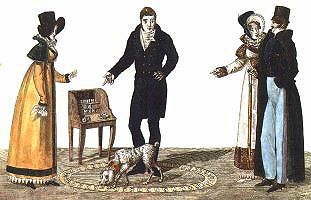This ban wasn't out of concern for public
safety, but because the privilege of showing rare animals (and the associated revenues) belonged to the
keeper of his Majesty's lions, at the Tower of London London
 |
| Inside the Exeter Exchange (also known as the Exeter 'Change) |
Gilbert Pidcock bought a four-storey
building, the Exeter Exchange, in the Strand .
It seems likely Pidcock wanted a place to overwinter his animals when not touring the country,
and later realised there was a demand to exhibit in London all year round. His
collection of exotic animals included a rhinoceros, kangaroo, zebra, lynx and
some rare birds. Later he added tigers and an elephant. The latter is all the
more surprising because the animals were kept indoors - on
the first floor and above - the ground floor being occupied by shops.
Pidcock's Menagerie grew in popularity at a
time when the Tower Menagerie was shabby and in decline. Although situated in central London
 |
| The Stand, London - in the 19th century |
When Pidcock died in 1810 the menagerie
eventually came under the ownership of Edward Cross (Pidcock's deputy and a
skilled animal keeper) Cross had an eye for publicity and in adverts likened
himself to:
"…that
primeval collector of natural curiosities, Old Noah."
 |
| Edward Cross |
Indeed, Cross' collection included Chunee
(an elephant), Nero (a large lion), four other lions, tigers, leopards,
jaguars, antelopes, camels, llamas, bison and sea lions! That's not to mention
a large collection of birds from ostriches, to five species of eagles, and
vultures.
The menagerie was open 9 am to 9pm and it
cost a shilling to see the three main exhibits, or two shillings to view
everything. The most popular time to visit was at 8pm when the animals were
fed and Chunee, the elephant rang a loud bell to signal the start of feeding time.
"The
Lords of Parliament and the lions of Exeter
William Clarke, journalist.
William Clarke, journalist.
 |
| The Exeter Exchange - note the banner displaying exotic animals. |
And finally: one famous visitor to the
menagerie was Lord Byron. He remarked that the face of the hippopotamus
reminded him of Lord Liverpool (the Prime Minister) - [This seems rather
dubious since no record exists of a hippo being exhibited] Other illustrious
visitors included Princess Victoria (the future Queen), Robert Browning and
Charles Dickens.
 |
| The caption reads : Exeter Change, Strand, site of Edward Cross's menagerie, shortly before its demolition in 1829 |
The Wonderful Dog: Munito
The Learned Pig





















